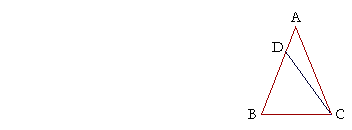Table of Contents | Introduction | Home
![]()
P l a n e G e o m e t r y
An Adventure in Language and Logic
based on

PROOF BY CONTRADICTION
Book I. Proposition 6
THE NEXT PROPOSITION is the converse of Proposition 5. It is our first example of proof by contradiction, also known as the indirect method of proof. We could also call it, "proof by consequences"!
Thus, suppose we want to conclude that statement a is true. Then we take as our hypothesis that a is false, and we see the consequences of that. We show in fact how that leads to an absurd conclusion -- that 2 is less than 1, for example. But when the conclusion is false, the hypothesis must be false. (Introduction to logic, Problem 19c.) Statement a, therefore, is not false; it is true.
Historically, proof by contradiction was known as reductio ad absurdam.
PROPOSITION 6. THEOREM
| If two angles of a triangle are equal, then the sides opposite them will be equal. | |
| Let ABC be a triangle in which angle ABC is equal to angle ACB; | |
| then side AB will equal side AC. | |
 |
|
| For if AB is not equal to AC, | |
| then one of them is longer. | |
| Let AB be longer, and from AB cut off DB equal to AC, which is shorter; | (I. 3) |
| and draw DC. | (Postulate 1) |
| Then, since we have constructed DB equal to AC, | |
| and BC is common to triangles DBC, ACB, | |
| the two sides DB, BC are equal to the two sides AC, CB respectively; | |
| and angle DBC is equal to angle ACB; | (Hypothesis) |
| therefore triangles DBC, ACB are equal areas, | (S.A.S.) |
| the smaller to the larger -- which is absurd. | (Axiom 5) |
| Therefore the assumption that AB is not equal to AC is false; that is, it is equal to it. |
|
| Therefore, if two angles of a triangle are equal, then the sides opposite them will be equal. Q.E.D. | |
![]()
From now on, we will conclude a theorem with the traditional Q.E.D., and a problem with Q.E.F.
Thus, to prove that AB is equal to AC, we show that its contradiction -- AB is not equal to AC -- leads to an absurdity. This is proof by contradiction. A direct proof of this proposition will have to wait until we can both bisect an angle and prove congruence by Side-angle-angle.
This proposition provides a third way of knowing that straight lines are equal. Do you recall the other two ways? (See Problem 4.)
Please "turn" the page and do some Problems.
or
Continue on to the next proposition.
Table of Contents | Introduction | Home
www.proyectosalonhogar.com